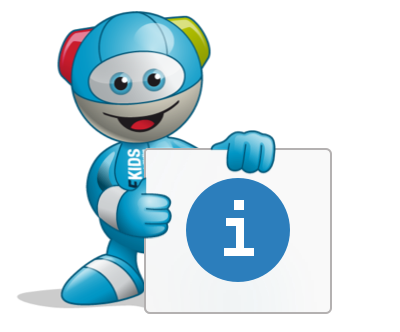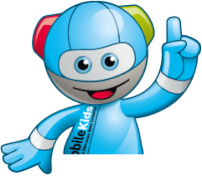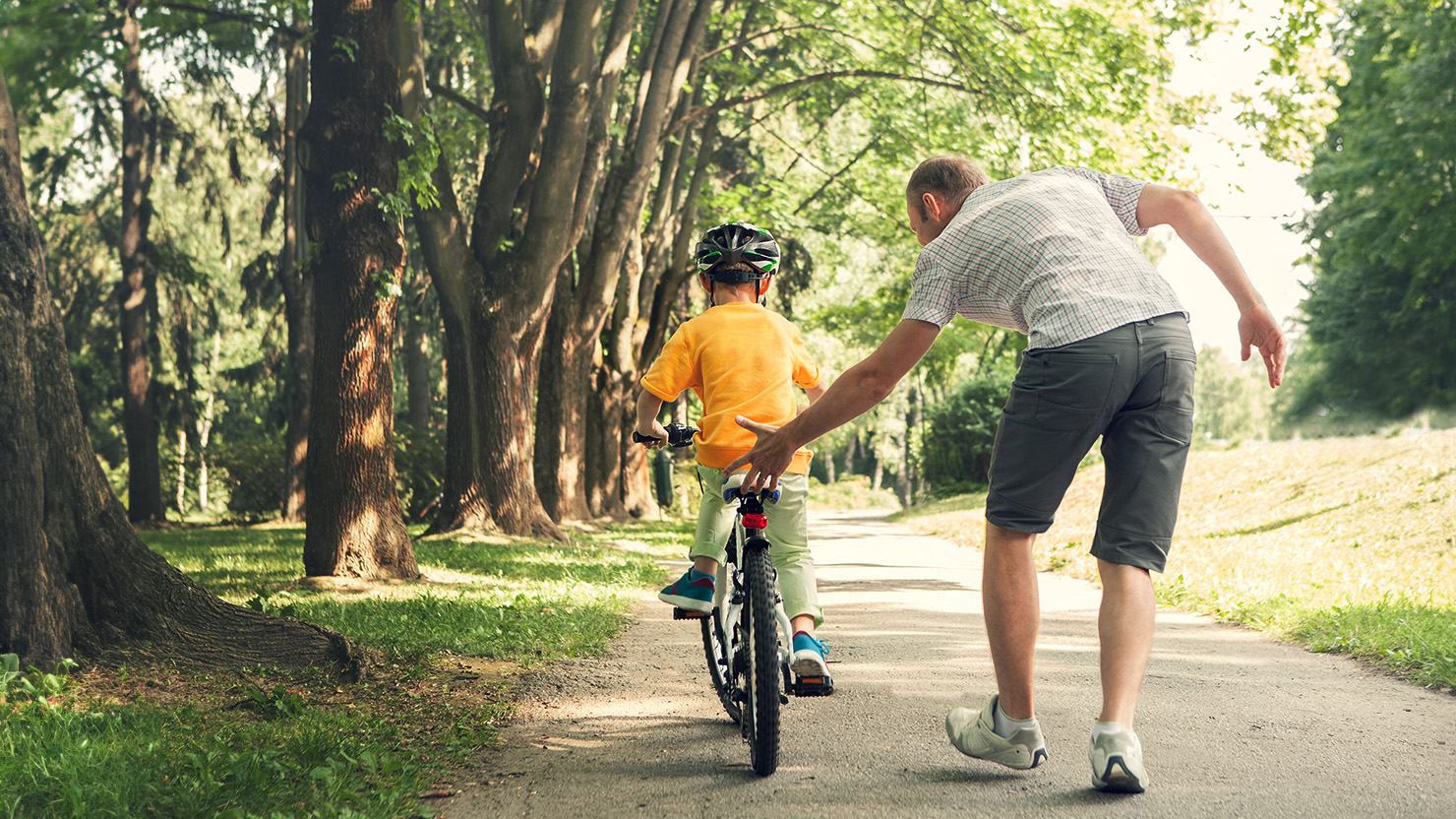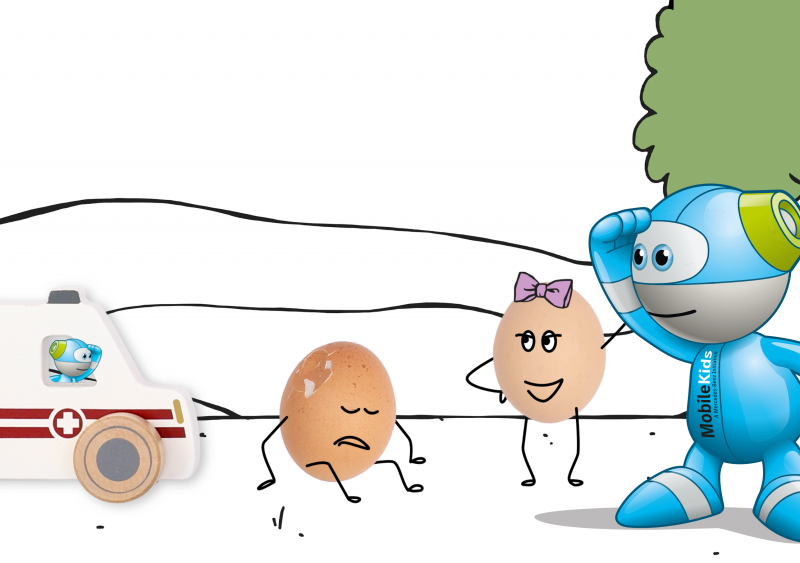Pedalling, steering and braking while paying attention to other road users – riding a bicycle is complex. Children need support before they can safely take to the saddle. Safe cycling is not only a basic requirement for passing the cycling test, it is also necessary in order ensure that all children will be safe on the road after the test.
At what age should children learn to ride a bike?
What matters more than age is whether a child already has the necessary body awareness and motor skills to control a bike. For many boys and girls, this is the case between the ages of three and four, while others need a little more time. Balance bikes and scooters are good preparation for safe cycling. If a toddler regularly lifts both feet on a balance bike, this may be a sign that they are ready for the first attempts at riding a bike with pedals.
How should the first bike be equipped?
Roadworthy children's bikes are available from a size of twelve inches, and are suitable for small cyclists up to around 95 centimetres tall. When seated on the saddle, the child's feet should be in contact with the ground without the legs being bent too much, though the heels may be off the ground. A low entry point not only makes it easier for the little ones to get onto the saddle, it also helps them to find their footing more quickly during the first, often wobbly manoeuvres.
Experts now advise against stabilisers. The additional wheels shift their weight outwards instead of inwards when cornering, and this prevents children from learning to keep their balance on bends right from the start. Furthermore, stabilisers can cause the child to fall if they become stuck in a pothole or at the edge of a pavement, for example.
If you are unsure about buying a children's bike, it is best to seek advice from a specialist dealer. A high-quality model is always worthwhile and can be easily passed on or resold later.

Size: Most children learn to ride a bike between the ages of three and four. Twelve inches is the smallest bike size available on the market. Depending on the child's height, the first bike can also be a 14-inch bike. The height of the saddle is important: when seated, the child should be able to place their feet flat on the ground.
Weight: The lighter the bike, the easier it is for children to learn to ride it. As a rule of thumb, children's bikes should weigh a maximum of one third of the bodyweight of their little riders. According to the ADFC, parents do not need to take this rule too strictly, but a child should be able to pick up the bike on their own if it falls over.
Equipment: Many things that are taken for granted on adult bikes can be dispensed with on children's bikes: lights, pannier, front basket and gears.
The right helmet: When buying a children's bike helmet, parents should be sure to choose the correct helmet size, which corresponds to the head circumference in centimetres. Children's helmets are available in sizes such as "45-49 cm", which roughly corresponds to the head circumference of a three year-old. Many helmets can be adjusted in size, and therefore usually cover a certain range (around 5 cm head circumference). For the best possible protection, the helmet must not fit too loosely.
Other features that a children's bike helmet should have:
- safety mark such as TÜV or GS mark
- sufficient ventilation
- padded straps on the chin and sides
Bicycle helmets should not be bought second-hand. The age of a helmet, its history – such as accidents or falls – and the weather conditions to which it has been exposed can have a negative impact on the protective effect.
Intact bicycle helmets that are less than five years old can be passed on to younger siblings, relatives or friends as long as it is absolutely certain that the previous owner did not have a fall with it. Signs of use and slight damage to the outer plastic shell – for example due to being dropped – are not detrimental to safety. A helmet must always be replaced after five years of use, regardless of how often or intensively it has been used.
Where should the first riding attempts take place?
Children attempting to ride a bike for the first time should be as far away from traffic as possible. Depending on the residential location, a courtyard or inner courtyard, a country lane on the outskirts or the nearest park may be suitable. The practice area should be as level as possible and free of obstacles.
Before the kids get on the bike, parents should show them the functions: how to use the brakes and how the pedals move. The next thing is to don the helmet and start the first attempts at riding, which will be even more successful if the tips below are followed.

- Give reassurance: When a small child sits on a bike for the first time, they need help. Parents can stabilise the child by the shoulders or back, but should avoid pushing so that the child learns to use the pedals. Mental support is just as important: Impatience and too much pressure rarely lead to success, but praise and encouragement motivate the child to stay on the ball – or rather on the bike. The focus should always be on having fun.
- Take away fear: As much as everyone involved may wish otherwise, falls cannot usually be avoided during the first few riding attempts. The parents' job is to take away their child's fear of falling, and encourage them to get back on the bike after a fall. When learning to ride a bike, the usual rule applies: practice makes perfect. But if in doubt, parents should call a break before continuing. The child should not associate any negative feelings with cycling.
- Develop more skills: If children manage to stay safely in the saddle for a longer period of time, the next step can be a short bike ride with their parents. On bike rides, mums and dads might get their children to practise riding and braking on uneven surfaces, for example. In a park or courtyard, it may also be possible to draw a small slalom course with chalk so that young riders can practise cornering safely in a playful way.
Although it is not required by law, parents should set a good example when cycling, and wear a helmet themselves. And even if the child's first attempts don't prove very successful: sooner or later, almost all children will have that magical moment on a new bike that they will remember for the rest of their lives.



